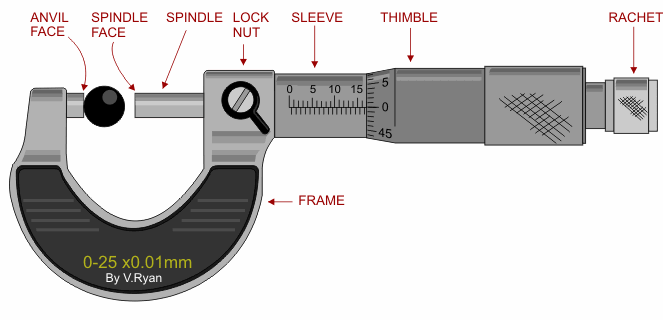There was a remark about the lathe flywheel I recently worked on. Something about the precision of previous eras.
They had more precision than you might think.
Today, one of the tools we use to measure accurately is a micrometer.

This magic device allows use to measure down to 0.0001, all because of a screw.
Inside the thimble is a threaded rod. It is 40 TPI on an imperial micrometer. When you turn the thimble one full revolution, the spindle advances 0.025 inches.
The thimble is marked with 25 evenly spaced marks. With just those, we can measure to 0.001″
But what about those 1/10,000s? That is done with another piece of old tech, the vernier.
If you take and mark the sleeve with 10 marks, with 9 spaces between them, such that the 10th mark aligns with the 11th mark (10 spaces) on the thimble, we have a vernier scale.
The lines of the vernier align with the lines on the thimble at exactly 0.0001 increments.
You can use this method in larger things as well. If I have a stick with 101 marks and I place that against a stick with 100 marks, I’ve created an ability to subdivide that stick by 100. It is pretty remarkable.
The Wheel
The wheel is laminated to create a width of 3 inches. The wood is a hardwood that does not expand or contract. One laminate is about 2 inches thick, and the other is 1 inch thick.
If we were to remake the wheel, we would likely do it with two layers, 1.5 inches thick.
The jointers create wheel layers by jointing two or more planks of equal thickness together to make a single plank, 44+ inches wide in both directions.
To hold the laminates together, holes are drilled in each plank, about a foot apart. The holes are then transferred to the other layer. The other layer then has the hole drilled slightly offset. When the wooden pegs are driven into the holes, that offset pulls the planks together to make everything tight.
A piece of cordage or a beam compass can be used to draw the perimeter of the wheel. This would be at 44+ inches.
The laminate would be trimmed close to the line but not touching.
A hole would be drilled at the center point, and then made square with chisels.
The entire thing would then be mounted on a spindle to drive it. That could be as simple as two benches with a groove to hold the spindle. The wheel would then be spun up to speed.
A tool rest, would be brought in, the craftsman would then use his lathe chisels to make the wheel completely round. This is an easy, but time-consuming process.
It is easy because the task is to slowly move the chisel from one edge to the other. The speed of that movement requires that the cutting chisel be in contact with the work for one complete revolution.
Since the wheel is turning slowly, 40 to 60 RPM, it means that you can only move a 1/16th of an inch per revolution, or so.
After the wheel is turned true (completely round), the crown is put in via the same method.
A reasonable person turning a wheel like that can expect to get a 44-inch wheel running true within 1/32 of an inch, without having to work at it. It is easy.
There are entire volumes written about making things flat or straight. If you can make something flat or straight, you can make right angles. It is not difficult. If you can make right angles, you can make many other angles.
While the micrometer is a new invention, a simpler tool was used before, it was just a straight stick that was fairly long. It was placed on a pivot, near the nose of the stick. The other end moved across some sort of scale. As the nose moves, the tail moves more. If the distance from the pivot to the nose point is 0.5 inches, and the distance from the pivot to the tail point is 12 inches, every movement of the nose is amplified 24 times.
While you might not be able to see a movement of 0.001 in the nose, you can see the movement of 0.024 in the tail.
We can have precision with simple, old tools. It just takes a bit of work to get there.

as humans we tend to over complicate things. “well, if I had THESE tools, I could do that.” when in reality you have the best tool of all- a brain…. there are many projects that we can do with shear determination..
Harrison’s first marine chronometers were mostly made out of wood,, and extremely precise by 18th century standards. He did switch to metal components for greater stability later on.